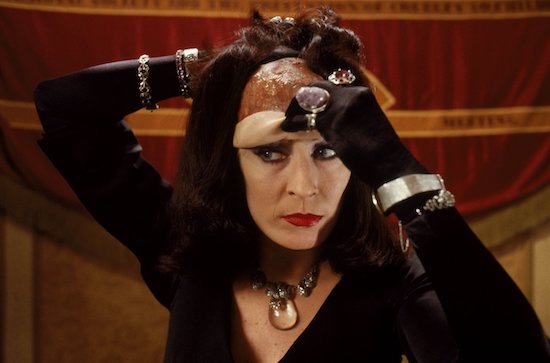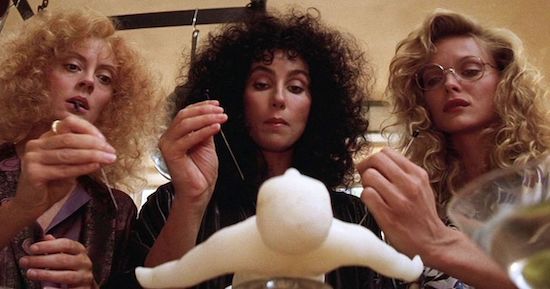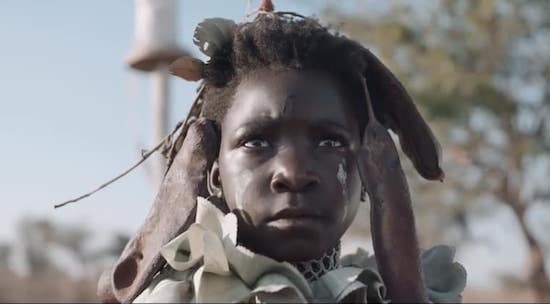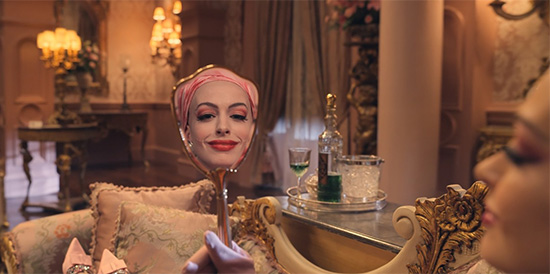High heels, spindles and pussies: the Hollywood witch, fluffed to thrill, is growing mutinous. Before the election, America’s real-life protest witches gathered to hex Donald Trump; and Robert Back To The Future Zemeckis’ updating of Roald Dahl’s The Witches was released. Anne Hathaway strutted into Stanley Tucci’s mansion hotel, overlooking the Gulf of Mexico, wearing houndstooth, and my hopes were raised for couture-clad anarchy.
Sadly, they weren’t entirely fulfilled, though Hathaway strains at her leash of stylish campery. Sugar overwhelms the real-life spice of racism stirred into the plot, I presume, by Zemeckis’ co-writers, Pan’s Labyrinth filmmaker Guillermo Del Toro and Kenya Barris, the creator of Blackish. It’s gingerbread storytelling, lacking zest. The tastiest morsels are the film’s early scenes of Southern Gothic and explicit racial apartheid, belonging to a saltier script, and Hathaway’s brass bra, which deserves a film of its own. In fact, the struggle between the mealy wokeness of her writers and Hathaway’s pointedly sexy Grand High Witch got me thinking about cinema’s entanglement with unruly women. From Bewitched and Witches of Eastwick to The Love Witch and Disney’s two Maleficent films, witches have a way of slipping from their male creators’ grasp.
The film witch is often a long-legged fantasy of patriarchy, whose evil beauty shatters families. Tinkling piano and glittering visuals signal her enchantments, as in one of Zemeckis’ opening scenes that uses his signature special effects, in a blizzard of broken glass. It’s 1968, the year that crystalised the hopes and agonies of American race rights activism. A little Black boy has just survived the car crash that kills his parents. Raymond is sheltered by his Alabama grandmother (the redoubtable Octavia Spencer). “Safety first” is her catchphrase. But despite being a “voodoo priestess”, with a den of herbs and crystals, a witch is watching them. They escape to The Grand Orleans Hotel, because Grandma insists witches only prey on “rich white folks.” She’s wrong. A convention of witches turns Raymond into a mouse, forever.
My critic’s circle of 9-11 year olds were riveted by the CGI-extended arms of The Grand High Witch (whom I’ll henceforth call the GHW). I was more intrigued by Hathaway’s Nazi glamour, which rises dazzlingly above the film’s jumbled critique of white supremacy. With her Dietrich-like blonde hair, Hathaway marches her troops to a goose-stepping beat. Ditching the GHW’s original Norwegian roots, her accent r-o-l-l-i-n-g more towards Berlin than Oslo, she snarls at her coven from her podium like a fascist dictator. With her Rhinemaiden milky skin, Joker-like smile and supermodel curves, she’s the rampant realisation of an überfrau. And, since a witch’s wardrobe is often the source of her mystery, her dollars are stashed in vast Louis Vuitton-esque clothes trunks.
The missing fingers of this scarred GHW have offended viewers who are differently limbed. Those points of appetite, mouth and fingers, suggest her male creators, are deformed by her luxuriant excesses. Hathaway has apologized, but the prejudice is symptomatic of the patriarchal myths that fuel witch-hunting in Africa today – the tragedy that drives I Am Not A Witch. Roald Dahl’s original GHW is "the most evil and appalling woman in the world,"and frankly, it would be exciting if Zemeckis’ GHW was more appalling. There’s no grotesquerie here, physical or moral, to rival Anjelica Huston pushing a pram down a hill in Nicolas Roeg’s superior 1990 film of the same story.

Zemeckis, negotiating America’s twin obsessions of wealth and race, fails to exploit the perverted Romantic ideals of his rich white bitch of a GHW, who longs to cleanse the world of Black, poor and fat children (posh Bruno, who gets mousiefied, is another swipe at disobedient bodies). The GHW reclines among brocade sofas, surrounded by ice buckets of her mouse-making formula. Raymond and his grandma hand out dollars to Black bellboys. But the GHW disdains the drudgery behind luxury. It’s industrial domestic drudgery, after all, that spawned the spindle. “Why,” she drawls, “In this disgusting human world, do you need money for everything?”
Chandeliers and rococo hallways similarly sparkle in George Miller’s 1987 film The Witches of Eastwick. It’s a rollicking take on the irritating novel by that worshipper of feminine mystique, John Updike. Like most men who poeticise women, Updike fears them, too.
Michelle Pfeiffer, Cher and Susan Sarandon play Sukie, Alex and Jane, a reporter, sculptor and sexually-harassed cellist, respectively. Buried alive in the conservative town of Eastwick, lightning flashes when they clink martini glasses; storm clouds roil when they bicker. However, apart from Sukie, a mother of six, her intuition evidently stimulated by semen, the women don’t realise their burgeoning powers until they accidentally summon “a tall, dark Prince travelling under a curse.”
The Devil arrives, in the form of squat, hairy Darryl Van Horne (Jack Nicholson), in hi-tops and kimonos, balding, with a pony-tail. He woos the women into a menage à quatre – though, this being Updike, lesbianism is barely referenced and at the service of men.
The Devil’s role is to “tickle” them, particularly the childless Alex and Jane, into black lace, gold lame, sex and babies. Laughing, they learn to fly. Darryl cossets his girlfriends with a Warner Bros luxury that reappears in The Witches : monogrammed robes, Persian rugs, silver bowls of cherries. Obsessed with milky tits and fertile wombs, he makes self-consciously hokey speeches about gender. But Darryl listens, too. In a gloaming of candlelit water, he gobbles up Sukie’s observation that “men need to feel that the world is solid, but the truth is, the world is not like that.” Overthrown by his impregnated beauties, Darryl’s fear of their sexual autonomy explodes: “Ungrateful little bitches! Do you think God knew what He was doing, when He created Woman?”

This fundamental horror of Woman similarly stalks The Witches; the freaky frisson of what lies beneath. Seeing the GHW rapturously rolling her unwigged, bald head is like catching your mother masturbating in the bath.
The GHW’s terrifying arms suggest a mother’s clutches, but her mesh-plated bustier is not for babies, or blokes. When she strips, she does it for herself, not her cowering coven. “You trussed-up succubines,” she spits, commanding them to de-wig. “Prepare for removal!”
What’s really “appalling” about this GHW is that her puss is her own.
“I will never, ever,” hisses Hathaway, to hotel manager Stanley Tucci, who proffers her cat a gilded cage, to enter his restaurant, “allow my precious puss to be caged!”
The cat obliges, the GHW does not.
*
By contrast, Elaine, in Anna Biller’s witty period satire The Love Witch, devotes her pussy to men. Expressing Sukie’s view that the world is not solid, Biller’s film hovers between sunlit city streets, deer-springing forests and the 1960s and 1970s – the birth-time of the original bouffant-haired witch, Samantha in Bewitched. Her own hairpiece flowing, Elaine drives sports cars to dates where she cooks men steak and loves them to death with sexy stripteases. This is a film for every woman who’s performed for men and later felt icky; but it’s also for women tickled by the matching of Elaine’s turquoise knickers to her eyeshadow. The sapphic subtext is comically proposed by The Victorian Tea Room, a ladies-only haven of pink linen and harpsichord.
It’s a café that might be appreciated by Samantha, who, in Bewitched, marries unsuspecting ad man Darrin and tries to be a mortal mother. “All I want,” Samantha promises him, “is the normal life of a normal housewife.”
In the early seasons of the show, actor Elizabeth Montgomery wears drab shirt-dresses. But as the sitcom runs on and Second Wave feminism lifts off, Samantha floats in diaphanous black and a glut of greens, from pondweed to emerald. In a 1992 interview with gay magazine The Advocate , asked if the series was an allegory for closeted homosexuality, Montgomery said, “If you think about it, Bewitched is about repression in general and the frustration it can cause.”
Unchecked repression brews more than frustration. Accused of witchcraft in African societies, girls today are being murdered.

In her stunning 2017 debut, I Am Not A Witch, Rungano Nyoni reproduces the wigs and spindles of the witch, yoking them to a comic tragedy of a young girl that’s disturbingly beautiful. Shula (an intense performance by Maggie Mulubwa), has “no family, no friends.” Accused of witchcraft, she must choose between admitting she’s a witch or becoming a goat. Huge reels of white ribbons enchain Shula and the elder witches she calls ‘grandmothers’. Like Grandma in The Witches, Shula’s elders cannot protect her. In the fields, she labours in sunlight, earth and sweat. Exhibited to tourists, she’s a bundle of pale cotton and proud feathers. Manipulated into being the “little witch” of a corrupt politician, Shula hangs herself by her ribbon. “I should have chosen,” she says, “to be a goat.”
Angelina Jolie’s two Maleficent films, retelling the story of the villainess who curses Sleeping Beauty, outline the impossibility of an unwed woman’s choices. Both films were critically maligned, though they’re gorgeously animated and droll, Jolie twisting her prosthetic cheek-boned hauteur with wit. I suspect Jolie, who adopted four of her six children in real life, is more powerful, beautiful and motherly than Hollywood thinks women should be. Certainly, the family structure proposed by her writing team, led by Linda Woolverton, threatens the norm.
Maleficent is a faery in a moorland where status doesn’t exist, until she’s forced to protect it from colonial aggression from the human kingdom. In an act of quasi date-rape, the mortal she loves literally clips her wings. Her dark horns and batlike cloak sheath the pathos of her tigerish eyes. When he profits from his ravaging to become king of the humans, Maleficent curses the king’s daughter with sadistic relish (“I like you begging. Do it again”). But her maternal instincts take over. She adopts the girl, Aurora.
The moors give Aurora a home of moonlit mountains, where “true love’s kiss” is not one foisted on you by a prince you’ve barely met. This queerish utopia is disrupted, in the second film, by marriage to the son of a queen who wants to cleanse the moors with biological weapons. The sparring between Jolie and the pearl-clad, frigid Michelle Pfeiffer, who, like the GHW, is another fascist blonde, is delicious. It’s a drag when Jolie is rescued by a Black saviour (Chiwetel Ejiofor) and the film topples into a woke origin story involving indigenous tribes.
Maleficent’s final transformation, into a flaming phoenix, proves that witches cannot win through human form. It’s a weepy moment when she sacrifices her body for her daughter and finally wins the term “mother”. But at what cost?
Maleficent’s sexuality, abused by a corrupt mortal, is repressed. She’s at her most magnificent when her tread sends flying ancient stone walls and armoured soldiers. These fantasy films, along with Zemeckis’ shining white beast of a GHW, celebrate witches who have more fun indulging their selfish animal appetites. I dream of the next evolution of this kind of witch, whose unbiddable beauty will vanquish the male wet-dreams that bred her.


